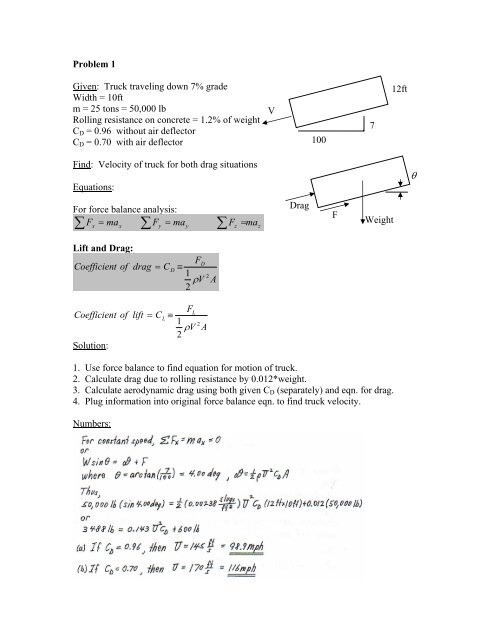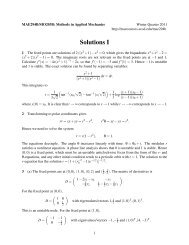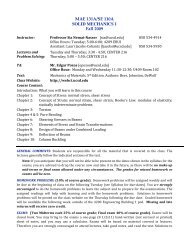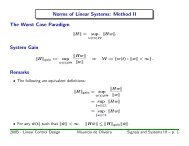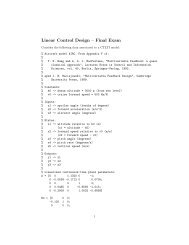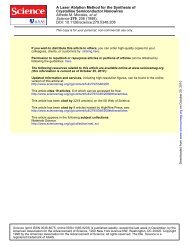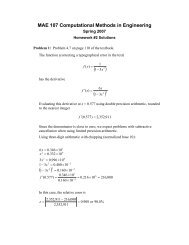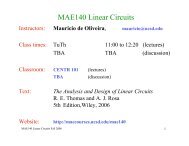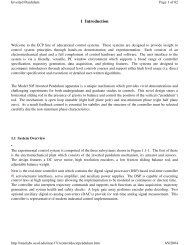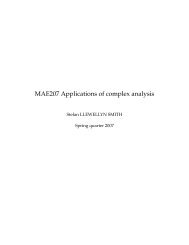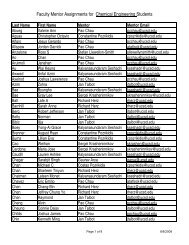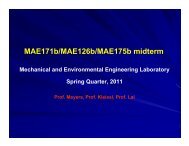Homework Solution 3
Homework Solution 3
Homework Solution 3
You also want an ePaper? Increase the reach of your titles
YUMPU automatically turns print PDFs into web optimized ePapers that Google loves.
Problem 1<br />
Given: Truck traveling down 7% grade<br />
Width = 10ft<br />
m = 25 tons = 50,000 lb<br />
Rolling resistance on concrete = 1.2% of weight<br />
CD = 0.96 without air deflector<br />
CD = 0.70 with air deflector<br />
Find: Velocity of truck for both drag situations<br />
Equations:<br />
For force balance analysis:<br />
F x = max<br />
Fy<br />
= ma y Fz<br />
maz<br />
∑ ∑ ∑ =<br />
Lift and Drag:<br />
Coefficient<br />
Coefficient<br />
<strong>Solution</strong>:<br />
of<br />
drag = C<br />
D<br />
FD<br />
≡<br />
1<br />
ρV<br />
2<br />
FL<br />
of lift = CL<br />
≡<br />
1<br />
ρV<br />
2<br />
2<br />
A<br />
2<br />
A<br />
V<br />
Drag<br />
100<br />
F<br />
7<br />
Weight<br />
1. Use force balance to find equation for motion of truck.<br />
2. Calculate drag due to rolling resistance by 0.012*weight.<br />
3. Calculate aerodynamic drag using both given CD (separately) and eqn. for drag.<br />
4. Plug information into original force balance eqn. to find truck velocity.<br />
Numbers:<br />
12ft<br />
θ
Problem 2<br />
Given: Box kite blowing in wind<br />
U = 20ft/s<br />
Vwind = 20 ft/s<br />
W = 0.9 lb θ<br />
Tension in string = 3.0 lb<br />
Angle to ground = 30 o<br />
Frontal area = 6.0 ft 2<br />
Find: a) Determine the lift and drag coefficients<br />
b) If Vwind = 30 ft/s and CD and CL are as found, will the kite rise or fall?<br />
Assumptions:<br />
Equations:<br />
For force balance analysis:<br />
F x = max<br />
Fy<br />
= ma y Fz<br />
maz<br />
∑ ∑ ∑ =<br />
Lift and Drag:<br />
Coefficient<br />
Coefficient<br />
<strong>Solution</strong>:<br />
a)<br />
of<br />
drag = C<br />
D<br />
FD<br />
≡<br />
1<br />
ρV<br />
2<br />
FL<br />
of lift = CL<br />
≡<br />
1<br />
ρV<br />
2<br />
1. Find the density of air from Table A.9.<br />
2<br />
A<br />
2<br />
A<br />
2. Use force balance in both x and y to find equations for drag and lift respectively.<br />
3. Using equations for lift and drag calculate CD and CL.<br />
b)<br />
1. Plug new velocity into equations for lift and drag and recalculate θ .<br />
y<br />
x<br />
T<br />
L<br />
W<br />
D
Numbers:
Problem 3<br />
Given: Old airplane with wires used to strengthen design, with: U = 70mph, Awing =<br />
148 ft 2 , CD wing = 0.020, Lwire = 160 ft, Dwire = 0.05 in<br />
Find: Ratio of drag from wire bracing to that from the wings<br />
Assumptions: (1) Wires modeled as smooth cylinders<br />
Equations:<br />
Lift and Drag:<br />
FD<br />
Coefficient<br />
of drag = CD<br />
≡<br />
1 2<br />
ρV<br />
A<br />
2<br />
FL<br />
Coefficient<br />
of lift = CL<br />
≡<br />
1 2<br />
ρV<br />
A<br />
2<br />
<strong>Solution</strong>:<br />
1. Calculate the Reynolds number of the wire braces.<br />
2. Look up CD for wires in Fig 9.13.<br />
3. Calculate Dwire / Dwing.<br />
Numbers:
Problem 4<br />
Given: Old airplane with wires used to strengthen design, with: U = 150 km/h, Lwire =<br />
60 m, Dwire = 6 mm<br />
Find: Power required to move the guy wires<br />
Assumptions: (1) Wires modeled as smooth cylinders<br />
Equations:<br />
Lift and Drag:<br />
FD<br />
Coefficient<br />
of drag = CD<br />
≡<br />
1 2<br />
ρV<br />
A<br />
2<br />
FL<br />
Coefficient<br />
of lift = CL<br />
≡<br />
1 2<br />
ρV<br />
A<br />
2<br />
<strong>Solution</strong>:<br />
1. Look up the kinematic viscosity and density of air at 15 o C in Table A.10.<br />
−5<br />
2<br />
3<br />
ν = 1. 45x<br />
10 m / s,<br />
ρ = 1.<br />
23kg<br />
/ m<br />
2. Calculate the Reynolds number of the wire braces.<br />
km 1000m<br />
1hr<br />
1m<br />
150<br />
6mm<br />
UD<br />
=<br />
hr 1km<br />
3600s<br />
1000mm<br />
= 17,<br />
241<br />
5<br />
ν<br />
1.<br />
45x10<br />
m / s<br />
Re = − 2<br />
3. Look up CD(Re) for wires in Fig 9.13. CD ~ 1.2<br />
4. Calculate the force of drag using the equation for the coefficient of drag.<br />
FD<br />
CD<br />
≡<br />
1 2<br />
ρV<br />
A<br />
2<br />
FD<br />
1.<br />
2 =<br />
3<br />
2<br />
( 0.<br />
5)(<br />
1.<br />
23kg<br />
/ m )( 150km<br />
/ hr * 1000m<br />
/ km * 1hr<br />
/ 3600s)<br />
( 0.<br />
006m)(<br />
60m)<br />
F<br />
D<br />
=<br />
461.<br />
25<br />
N<br />
5. Now calculate power necessary, knowing P = FV = (461.25 N)(41.7m/s) = 19.2 kW.
Problem 5<br />
Given: Optimally faired wires of the same length and other properties as in problem 4<br />
Find: Percent power saved by fairing guy wires<br />
Equations:<br />
Lift and Drag:<br />
FD<br />
Coefficient<br />
of drag = CD<br />
≡<br />
1 2<br />
ρV<br />
A<br />
2<br />
FL<br />
Coefficient<br />
of lift = CL<br />
≡<br />
1 2<br />
ρV<br />
A<br />
2<br />
<strong>Solution</strong>:<br />
1. Look up the kinematic viscosity and density of air at 15 o C in Table A.10.<br />
−5<br />
2<br />
3<br />
ν = 1. 45x<br />
10 m / s,<br />
ρ = 1.<br />
23kg<br />
/ m<br />
2. Calculate the Reynolds number of the wire braces.<br />
km 1000m<br />
1hr<br />
1m<br />
150<br />
6mm<br />
UD<br />
=<br />
hr 1km<br />
3600s<br />
1000mm<br />
= 17,<br />
241<br />
5<br />
ν<br />
1.<br />
45x10<br />
m / s<br />
Re = − 2<br />
3. Look up CD(Re) for streamlined strut in Fig 9.14. CD ~ 0.06<br />
4. Calculate the force of drag using the equation for the coefficient of drag.<br />
FD<br />
CD<br />
≡<br />
1 2<br />
ρV<br />
A<br />
2<br />
FD<br />
0.<br />
06 =<br />
3<br />
2<br />
( 0.<br />
5)(<br />
1.<br />
23kg<br />
/ m )( 150km<br />
/ hr * 1000m<br />
/ km * 1hr<br />
/ 3600s)<br />
( 0.<br />
006m)(<br />
60m)<br />
F<br />
D<br />
= 23N<br />
5. Now calculate power necessary, knowing P = FV = (23 N)(41.7m/s) = 960 W.<br />
6. Comparing this to the power in problem 4:<br />
P − Pstreamline<br />
19,<br />
200W<br />
− 960W<br />
x100<br />
% =<br />
x100%<br />
= 95%<br />
less power necessary!!!<br />
P<br />
19,<br />
200W
Problem 6<br />
Given: Spherical hailstones, D = 10mm, falling through air at STP<br />
Find: Terminal velocity<br />
Equations:<br />
(1)<br />
Coefficien t of<br />
<strong>Solution</strong>:<br />
drag = C<br />
D<br />
FD<br />
≡<br />
1<br />
ρV<br />
2<br />
2<br />
A<br />
−5<br />
2<br />
1. Look up properties for air in Table A.10: ν = 1. 45x<br />
10 m / s,<br />
ρ = 1.<br />
23kg<br />
/ m<br />
2. Look up the specific gravity of ice in Table A.1 and calculate the density of ice.<br />
= 0. 917 → ρ = SG ρ 2<br />
3<br />
3<br />
= ( 0.<br />
917)(<br />
1000kg<br />
/ m ) = 917kg<br />
/ m<br />
SGice ice ice H 0<br />
3. Since the sum of the forces in y is zero when terminal velocity is reached, sum<br />
forces:<br />
∑<br />
Fy = 0 = mg − FD<br />
4. Rearrange equation (1) for the drag force and plug it into the force balance<br />
equation just found to find Vt.<br />
mg = C<br />
D<br />
( 0.<br />
5)<br />
ρV<br />
2<br />
t<br />
A<br />
→<br />
V<br />
t<br />
=<br />
2mg<br />
C ρA<br />
3<br />
3 π ( 0.<br />
01m)<br />
−4<br />
5. Calculate the mass of the hail: m = ρ V = 917kg<br />
/ m<br />
= 4.<br />
8x10<br />
kg<br />
6<br />
6. Calculate the area:<br />
7. Now calculate Vt(CD):<br />
πD<br />
A =<br />
4<br />
V<br />
t<br />
2<br />
π 0.<br />
01<br />
=<br />
4<br />
D<br />
2<br />
= 7.<br />
85x10<br />
−5<br />
m<br />
−4<br />
2<br />
2(<br />
4.<br />
8x10<br />
kg)(<br />
9.<br />
81m<br />
/ s ) 9.<br />
87m<br />
/ s<br />
=<br />
3<br />
5 2<br />
C ( 1.<br />
23kg<br />
/ m )( 7.<br />
85x10<br />
m ) C<br />
= −<br />
8. Assume CD is in the flat region of Figure 9.11 so that CD ~ 0.47.<br />
9.<br />
87m<br />
/ s<br />
9. Now calculate: Vt = = 14.<br />
4m<br />
/ s<br />
0.<br />
47<br />
Vt D ( 14.<br />
4m<br />
/ s)(<br />
0.<br />
01m)<br />
10. For this velocity calculate: Re = =<br />
= 9931<br />
−5<br />
2<br />
ν 1.<br />
45x10<br />
m / s<br />
11. Now go back to Figure 9.11 and look up CD for this Reynolds number: CD ~ 0.41<br />
9.<br />
87m<br />
/ s<br />
12. Recalculate: Vt = = 15.<br />
4m<br />
/ s<br />
0.<br />
41<br />
* Although hailstones are not perfectly spherical this is probably a good estimate<br />
2<br />
D<br />
D<br />
3
Problem 7<br />
Given: Bicycle with frontal A = 3.9 ft 2 , and CD = 0.88, and peddling at 15 mph in still air<br />
Find: Extra power necessary to peddle against a 20 mph head wind<br />
Equations:<br />
(1)<br />
Coefficien t of<br />
<strong>Solution</strong>:<br />
drag = C<br />
D<br />
FD<br />
≡<br />
1<br />
ρV<br />
2<br />
1. Look up density of air in Table A.10:<br />
2<br />
A<br />
ρ =<br />
0. 00238slug<br />
/ ft<br />
2. Change units of bike velocity: Vbike = 15 mph (88ft/s)/(60mph) = 22 ft/s<br />
3. Wind speed relative to bike: Vrel = (15+20)mph(88ft/s)/(60mph)=51.3 ft/s<br />
4. Rearrange equation (1) into an equation for drag:<br />
2<br />
3<br />
2 2<br />
−4<br />
2<br />
FD<br />
= 0. 5C<br />
D ρV<br />
A = ( 0.<br />
5)(<br />
0.<br />
88)(<br />
0.<br />
00238slug<br />
/ ft )( 039 ft ) Vrel<br />
= 4.<br />
08x10<br />
Vrel<br />
5. Get equation for power necessary to peddle bike:<br />
P = V F =<br />
=<br />
bike<br />
D<br />
−3<br />
2<br />
2<br />
( 22 ft / s)(<br />
4.<br />
08x10<br />
) Vrel<br />
0.<br />
0898Vrel<br />
6. Calculate power for peddling in still air:<br />
2<br />
2<br />
P = 0.<br />
0898Vrel<br />
= ( 0.<br />
0898)(<br />
22 ft / s)<br />
= 43.<br />
5 ft − lb / s<br />
7. Calculate power for peddling in 20mph headwind:<br />
2<br />
Prel = 0.<br />
0898Vrel<br />
=<br />
( 0.<br />
0898)(<br />
51.<br />
3<br />
ft / s)<br />
2<br />
= 236 ft − lb / s<br />
8. Additional power necessary: Prel –P = (236-43.5)(ft-lb/s)(1hp/550ft/lb/s) = 0.35 hp<br />
3
Problem 8<br />
Given: Power to overcome aerodynamic drag: P ~ U n<br />
Find: n<br />
Equations:<br />
(1) Power = UFDrag<br />
(2)<br />
Coefficient<br />
<strong>Solution</strong>:<br />
of<br />
drag = C<br />
D<br />
FD<br />
≡<br />
1<br />
ρV<br />
2<br />
1. Combining equations (1) and (2) for power:<br />
2<br />
A<br />
= 0. 5UC<br />
ρU<br />
P D<br />
2. For many vehicles the drag coefficient is essentially independent of Reynolds<br />
3<br />
number, thus CD is not a function of U so that =<br />
0. 5C<br />
ρU<br />
A.<br />
So n = 3.<br />
P D<br />
2<br />
A
Problem 9<br />
Given: Cork ball in water with: d = 0.3m, SG = 0.12, angle = 30 o<br />
Find: Current speed, U<br />
Equations:<br />
(1) For force balance for stationary object:<br />
F x = 0 Fy<br />
= 0 Fz<br />
0<br />
(2)<br />
∑ ∑ ∑ =<br />
Coefficient<br />
<strong>Solution</strong>:<br />
of<br />
drag = C<br />
D<br />
θ<br />
FD<br />
≡<br />
1<br />
ρV<br />
2<br />
2<br />
A<br />
U<br />
FD<br />
W = mg<br />
Buoyancy force = FB<br />
Tension = T<br />
1. Do some geometry and use equations (1) to find in the x-direction: FD = Tcos30 o ,<br />
and in the y-direction: FB = W + Tsin30 o .<br />
2. Calculate the buoyancy force and weight of the ball: FB = ρgVol = (9.80<br />
kN/m 3 )(4π/3)(0.3/2 m) 3 = 0.1385 kN, and W = SG FB = 0.21 (0.1385 kN) =<br />
0.0291 kN<br />
3. Now balancing forces in the y-direction and using equation (2): 0.1385 kN =<br />
0.0291 kN + D tan30 o , Or D = 0.189 kN, where D = CD ½ U 2 A = CD U 2 (1/2)<br />
(999 kg/m 3 ) (π(0.3m) 2 /4) = 35.3CDU 2 N, where U ~ m/s.<br />
HENCE: (eq. A) 5.3 CDU 2 = 189 (in N) or CDU 2 = 5.35<br />
(eq. B) Re = UD/ν = 0.3m U/ 1.12x10 -6 m 2 /s =2.68 x 10 5 U<br />
4. Now the strategy is to use trial and error to determine U. Assume CD, then<br />
calculate U from Eq. (A) and Re from Eq. (B); check CD from Fig. 9.11, and<br />
iterate until CD’s converge. See below.<br />
Assume CD = 0.5 then from Eq. (A) U = 3.27 m/s and Re = 8.76 x 10 5 , and from Fig<br />
9.11 CD = 0.15 which does not equal 0.5 so try again<br />
Assume CD = 0.15 then from Eq. (A) U = 5.97 m/s and Re = 1.6 x 10 6 , and from Fig.<br />
9.11 CD = 0.20 which does not equal 0.15 so try again<br />
Assume CD = 0.19 then from Eq. (A) U = 5.31 m/s and Re = 1.42 x 10 6 , and from Fig.<br />
9.11 CD = 0.19 so U = 5.31 m/s
Problem 10<br />
Given: Flow around UN building where: w = 87.5m, h = 154m, CD = 1.3, U = 20 m/s<br />
Find: Drag<br />
Assumptions: (1) Air is at STP<br />
Equations:<br />
(1)<br />
Coefficient<br />
<strong>Solution</strong>:<br />
of<br />
drag = C<br />
D<br />
FD<br />
≡<br />
1<br />
ρV<br />
2<br />
1. Look up density of air at STP in Table A.10.<br />
2. Rearrange equation (1) to find:<br />
2<br />
A<br />
= 0. 5C<br />
ρV<br />
FD D<br />
3. Plug in the given conditions and calculate the drag:<br />
F D<br />
ρ = 1. 23kg<br />
/ m<br />
3<br />
2<br />
=<br />
( 0.<br />
5)(<br />
1.<br />
3)(<br />
1.<br />
23kg<br />
/ m )( 20m<br />
/ s)<br />
( 87.<br />
5m)(<br />
154m)<br />
= 4.<br />
31x10<br />
2<br />
A<br />
3<br />
6<br />
N
Problem 11<br />
Given: Flow around UN building where: w = 87.5m, h = 154m, CD = 1.3, U = 20 m/s at<br />
y = h/2 = 77m<br />
Find: Drag<br />
Assumptions: (1) Air is at STP<br />
Equations:<br />
(1) Velocity profile given: u = Cy 0.4<br />
(2)<br />
(3)<br />
Coefficient<br />
of<br />
drag = C<br />
total drag = FD<br />
= dFD<br />
<strong>Solution</strong>:<br />
∫<br />
D<br />
FD<br />
≡<br />
1<br />
ρV<br />
2<br />
1. Look up density of air at STP in Table A.10.<br />
2<br />
A<br />
ρ = 1. 23kg<br />
/ m<br />
2. Rearrange equation (1) to find C, knowing u(h/2): C = 20/(77 0.4 ) = 3.52<br />
3. Rearrange equation (2) to find:<br />
= 0. 5C<br />
ρV<br />
FD D<br />
2<br />
4. Plug this into equation (3) to find: FD = ∫∫ 0. 5C<br />
D ρ u dxdy<br />
5. Now plug in equation (1) and known values and integrate from the ground to the<br />
top of the building.<br />
F<br />
F<br />
D<br />
D<br />
2<br />
= 0.<br />
5C<br />
ρw<br />
∫ u dy = 0.<br />
5C<br />
ρwC<br />
D<br />
154<br />
0<br />
D<br />
⎡ y<br />
⎢<br />
⎣ 1.<br />
8<br />
2<br />
1.<br />
8<br />
3<br />
2 154<br />
= ( 0.<br />
5)(<br />
1.<br />
3)(<br />
1.<br />
23kg<br />
/ m )( 87.<br />
5m)(<br />
3.<br />
52)<br />
⎤<br />
⎥<br />
⎦<br />
154<br />
0<br />
1.<br />
8<br />
* Drag is just less than with a uniform flow profile<br />
2<br />
1.<br />
8<br />
A<br />
3<br />
6<br />
= 4.<br />
17x10<br />
N
Problem 12<br />
Given: Nuclear submarine cruising submerged<br />
V = 27 knots<br />
y<br />
x<br />
L = 107m<br />
δ<br />
w = pi*D = 34.6m<br />
Find: a) Estimate percentage of hull length with laminar BL<br />
b) Calculate drag due to skin friction<br />
c) Estimate power consumed<br />
Assumptions: (1) Can treat hull as a flat plate with same wetted area<br />
(2) Neglect laminar boundary layer (if small percent of hull length)<br />
Equations:<br />
Boundary Layer:<br />
Re transition = 500,<br />
000<br />
displacement<br />
*<br />
thickness = δ =<br />
momentum thickness = θ =<br />
∞<br />
∫<br />
0<br />
∞<br />
∫<br />
0<br />
⎛ u<br />
⎜1−<br />
⎝ U<br />
⎞<br />
⎟dy<br />
≈<br />
⎠<br />
u ⎛ u ⎞<br />
⎜1−<br />
⎟dy<br />
≈<br />
U ⎝ U ⎠<br />
Flow over flat plate parallel to the flow:<br />
friction drag = F = τ dA<br />
∫<br />
plate surface<br />
Turbulent Boundary Layer:<br />
5 x 10 5 < ReL < 10 7 :<br />
0.<br />
0742<br />
C D =<br />
Re<br />
1<br />
5<br />
L<br />
ReL < 10 9 :<br />
D<br />
w<br />
δ<br />
∫<br />
0<br />
δ<br />
∫<br />
0<br />
⎛ u<br />
⎜1−<br />
⎝ U<br />
⎞<br />
⎟dy<br />
⎠<br />
u ⎛ u<br />
⎜1−<br />
U ⎝ U<br />
⎞<br />
⎟dy<br />
⎠
C D =<br />
0.<br />
455<br />
(log Re<br />
L<br />
Lift and Drag:<br />
Coefficient<br />
Coefficient<br />
<strong>Solution</strong>:<br />
a)<br />
of<br />
)<br />
2.<br />
58<br />
drag = C<br />
D<br />
FD<br />
≡<br />
1<br />
ρV<br />
2<br />
FL<br />
of lift = CL<br />
≡<br />
1<br />
ρV<br />
2<br />
1. Look up value of viscosity of seawater in Table A.2.<br />
2. Calculate ReL.<br />
2<br />
A<br />
3. Calculate the ratio Rext / ReL which will give us the ratio xt / L.<br />
2<br />
A<br />
4. Multiply this ratio by 100% to get the percent of hull length with BL (it is small).<br />
b)<br />
1. Find CD using equation for turbulent boundary layer.<br />
4. Plug CD into equation to find FD.<br />
c)<br />
1. Power = FD V, so calculate the power.
Fox <strong>Solution</strong>:
Problem 13<br />
Given: Paddle wheel is immersed in a river current.<br />
Find: a) Expression for force produced by the wheel<br />
b) Expression for torque produced by the wheel<br />
c) Expression for power produced by the wheel<br />
d) Find the optimum angular speed, ω<br />
Assumptions: (1) Neglect air resistance since ρ air
Fox <strong>Solution</strong>:
Problem 14
Problem 15


